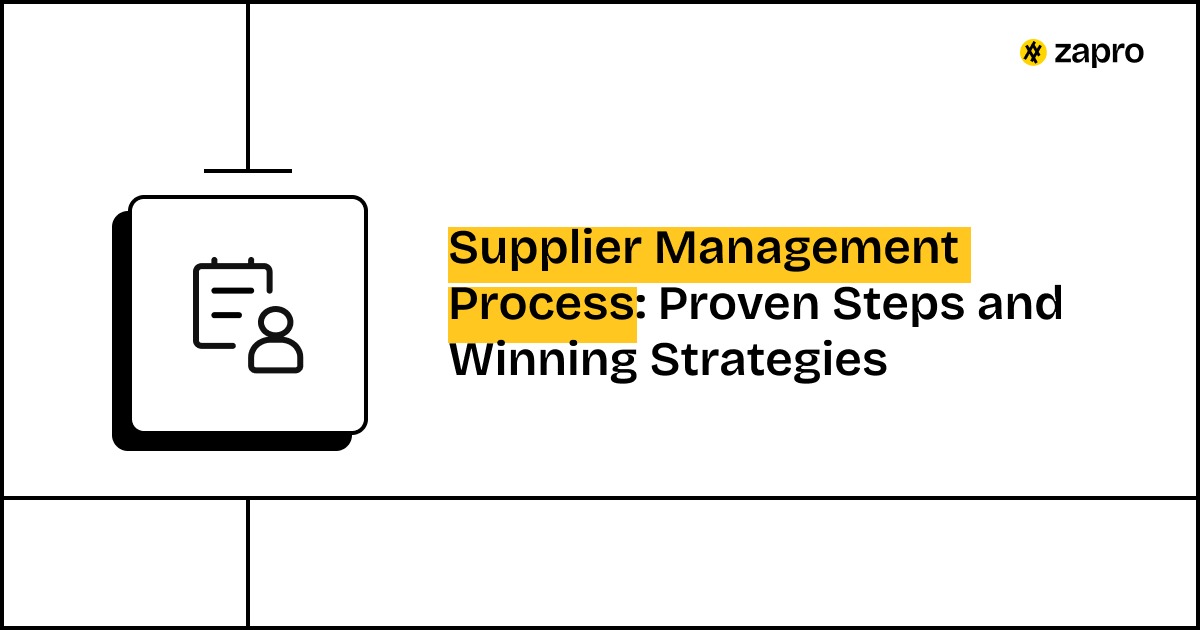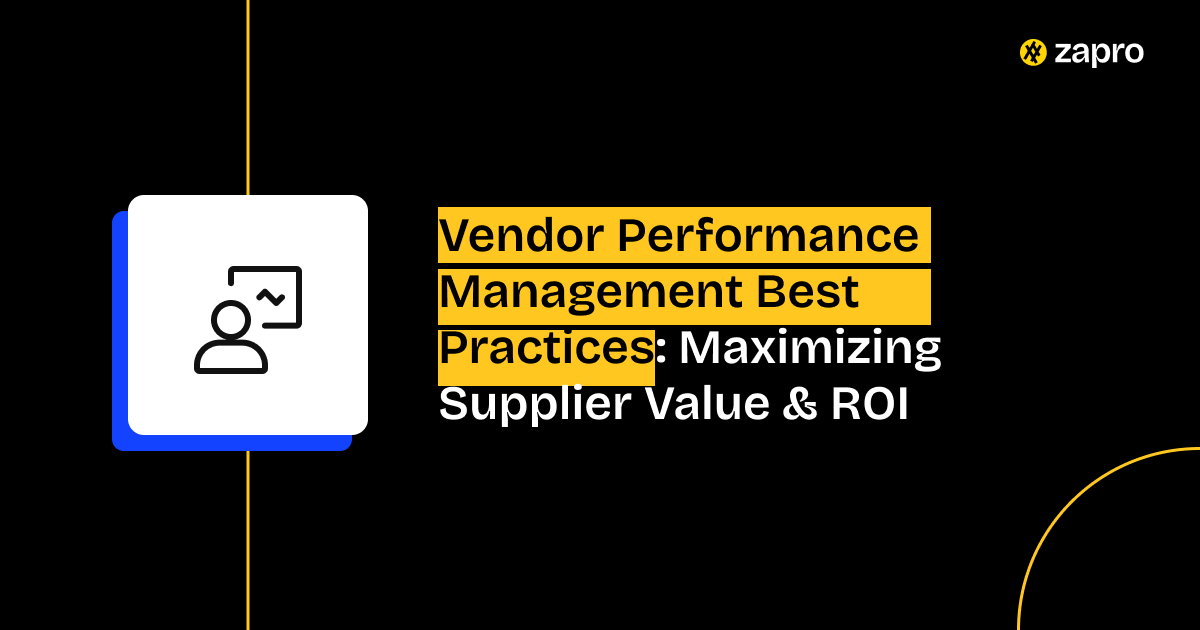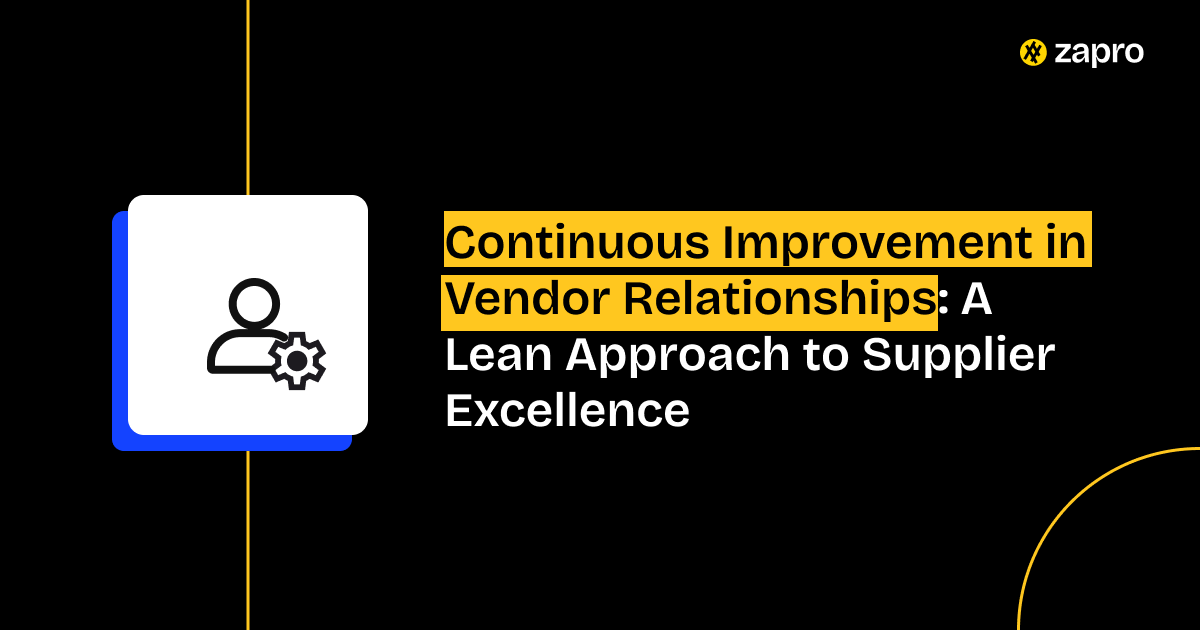What is supplier management?
The process of supplier management involves systematic oversight of business relationships with vendors who deliver products or services to organizations.
The complete supplier management process includes sourcing and onboarding suppliers and performance tracking and sustained business partnership development.
The main objective of supplier management involves obtaining quality products from compliant suppliers who work toward business objectives.
The strategic approach of supplier management differs from one-time purchasing because it focuses on building resilience and creating value while developing partnerships.
The current business environment requires supplier management to function as a strategic growth driver and risk control mechanism.
Importance of supplier management in modern business
The business world now recognizes supplier management as a vital operational function which drives organizational success and risk control. The following reasons demonstrate why supplier management stands as a vital business practice:
- Businesses that operate across different regions require structured supplier management to handle complex supply chains and prevent delays and shortages and non-compliance problems.
- Organizations face two main challenges because customers require dependable services while regulatory bodies enforce strict compliance standards. The system of supplier management enables organizations to fulfill both customer requirements and regulatory standards without sacrificing quality.
- Strong supplier relationships result in cost reduction while they’ve also allowed many companies to actually achieve process enhancements and innovation and shared operational efficiencies.
- At one point in time, supply chain disruptions become unavoidable because of geopolitical changes and natural disasters. The practice of effective supplier management creates organizations that can adapt quickly to changing circumstances.
- Organizations that establish strategic partnerships with suppliers instead of treating them as vendors achieve better efficiency and enhanced reputation and sustainable long-term growth.
Brief history of supplier management practices
Over a period of time, supplier management has evolved from a transactional function into a strategic discipline:
- Early 20th century: It was focused mainly on price and availability.
- Post–WWII: Reliability and quality became very crucial priorities.
- 1980s–1990s: Lean manufacturing and JIT practices made collaboration essential.
- 2000s onward: Globalization raised the stakes for compliance and risk control.
- Today: Digital tools, sustainability, and AI insights define modern supplier management.
| Before the early 20th century procurement practices treated suppliers as basic vendors through short-term performance-based relationships that focused solely on price reduction and immediate product requirements. – Logistics companies |
What are the key components of the supplier management process?
1. Supplier information management
` 89IOKM, MNKJIU98/7854230.The establishment of supplier information management serves as the core element for and maintain all supplier information which includes their certifications and financial data and compliance records and contact details.
A properly maintained supplier database located in one central location helps organizations avoid mistakes and duplicate entries while enabling better business choices.
2. Supplier relationship management (SRM)
The main objective of SRM is to create and sustain effective collaborative ties between organizations and their essential suppliers.
The objective of SRM is to establish relationships which advance beyond basic transactions to create partnerships that generate innovation and operational excellence and shared business expansion.
3. Supplier lifecycle management (SLM)
The supplier lifecycle management process usually includes all stages, right from supplier onboarding to performance assessment and ends with supplier renewal or even termination sometimes.
The lifecycle management process maintains very consistent operations and even regulatory compliance and also facilitates smooth transitions, pretty much at all points.
4. Supplier performance evaluation
Organizations use performance evaluations of suppliers to monitor their quality standards and delivery reliability and responsiveness and cost management performance. Performance evaluation systems help suppliers maintain accountability by showing them areas where they can improve their operations.
5. Supplier risk management of risks
Every business relationship with suppliers includes various types of risks which affect financial stability and operational performance and compliance and reputation. The process of supplier risk management helps organizations detect and evaluate potential risks which enables them to protect their supply chain operations from instability.
6. Supplier collaboration and innovation
The current approach to supplier management requires organizations to work together for creating shared value. Organizations are now working with suppliers to develop excellent products and improve their operational processes and implement sustainability programs.
It is an open secret that businesses that partner with suppliers achieve better market competitiveness and maintain readiness for any upcoming challenges.
7. Compliance & sustainability management
Businesses require their suppliers to fulfill both mandatory legal standards and corporate sustainability and ethical sourcing requirements.
The management of environmental social governance (ESG) compliance has evolved into a fundamental requirement for supplier management operations in worldwide supply networks.

Effortless Vendor Management
Keep vendor data organized, onboard suppliers easily, and track performance in one place.
The supplier management process flow
The supplier management process extends beyond basic contract signing and performance tracking because it requires a structured approach to evaluate and develop suppliers throughout their lifecycle.
The process consists of sequential stages which form a system to develop superior supplier connections and enhance supply chain stability.
Step 1: Supplier qualification
The first step of this process requires organizations to find suitable suppliers through evaluation procedures.
Organizations use financial stability and certification status and past performance records and production capacity and regulatory compliance standards to evaluate their suppliers. The qualification process selects dependable vendors who enter the system which helps organizations avoid early-stage risks.
Step 2: Supplier classification and segmentation
Different suppliers maintain distinct positions in the supply chain. Businesses organize their suppliers into three groups which include strategic suppliers and preferred suppliers and transactional suppliers based on their operational importance and risk level and purchasing volume.
The system enables organizations to distribute their resources optimally because it directs maximum resources toward essential suppliers.
Step 3: Supplier collaboration and communication
The process of supplier onboarding requires organizations to maintain continuous communication with their suppliers. The process requires businesses to exchange forecast data and establish common goals through technology platforms which enable transparent system updates. The practice of open collaboration helps organizations prevent misunderstandings while building enduring business partnerships.
Step 4: Contract negotiation and onboarding
The establishment of contracts serves as the base for defining all future expectations between parties. The negotiation process usually includes discussions about pricing and service-level agreements (SLAs) and delivery terms and compliance requirements.
The supplier onboarding process needs a very smooth transition. It includes practices like delivering essential tools and system access and training to help suppliers integrate efficiently into all business operations.
Step 5: Supplier performance monitoring and review
The evaluation process for suppliers continues after onboarding through assessments of their delivery performance and quality standards and their ability to respond and their pricing structure.
The evaluation process which occurs quarterly or annually helps organizations detect underperforming suppliers while rewarding top performers and upholding performance accountability.
Step 6: Continuous improvement & relationship strengthening
The process of supplier management requires very concerted, consistent, ongoing effort because it extends beyond just the initial setup. Organizations work together with their suppliers to discover ways to enhance operational efficiency and find cost-saving opportunities and product and process innovation potential.
It is these companies that build this trust through long-term partnerships that create conditions for mutual growth while developing a resilient supply chain.
Companies achieve business value through supplier management when they implement this structured process. The established process leads organizations to ask about the specific benefits they can achieve through successful implementation.
Benefits of an effective supplier management process
A supplier management process that follows a structured approach generates benefits that extend past operational efficiency. The process directly affects business profitability and supply chain resilience and market competitiveness.
Companies can easily achieve these essential advantages through effective supplier management:
1. Value creation and cost reduction
The process of supplier management requires more than price reduction negotiations to achieve success. Businesses achieve cost reduction through supplier consolidation and process optimization and collaborative relationships which minimize delays and errors and reduce inventory waste.
Long-term business relationships enable organizations to discover new opportunities for collaborative innovation and shared financial benefits.
2. Improved quality and reliability
The ongoing performance assessment system helps suppliers maintain their agreed-upon standards. The result of this approach leads to decreased product defects and shorter periods of equipment downtime and improved delivery performance.
The evaluation process of suppliers leads to higher levels of accountability because suppliers understand they will be assessed.
3. Risk mitigation and compliance assurance
The implementation of a structured supplier management system helps organizations protect themselves from financial losses and operational breakdowns and damage to their reputation. The system verifies that suppliers follow all applicable laws and industry rules and maintain compliance with internal organizational policies.
Businesses that maintain proper oversight can detect warning signs about supplier financial instability and ESG compliance deficiencies at an early stage.
4. Increased operational agility
Organizations gain fast market response capabilities through centralized supplier data management and performance tracking and communication systems.
The agile management of suppliers enables businesses to perform supplier changes and term renegotiations and execute operational scale-ups at higher speeds.
5. Supply chain transparency and visibility
The centralization of supplier data enables organizations to monitor their supply chain operations from start to finish. Decision-makers obtain complete visibility into their supplier base through access to supplier locations and performance metrics.
The clear supply chain information enables organizations to connect their supply chain plans with their sustainability goals and risk management initiatives.
6 Enhanced innovation and collaboration
The first to discover new materials and technological advancements and process enhancements are typically suppliers.
When businesses develop strong relationships with their suppliers they gain innovation partners who assist businesses in maintaining market competitiveness and developing new solutions together.
7. Stronger brand reputation
The current market environment shows that customers together with stakeholders focus on responsible sourcing practices and environmentally friendly supply chain operations. The practice of responsible supplier management helps organizations prevent scandals while building stronger brand trust and enhancing their corporate reputation.
Best practices and strategies in supplier management
The establishment of a process serves as the first step toward success.
Businesses need to adopt established methods which transform supplier management into a strategic operation that prepares for future challenges.
1. Establishing strategic targets and performance indicators
Organizations should link supplier management to their business targets through cost reduction and sustainability and time-to-market goals while using procurement KPIs to track delivery times and defect rates and risk assessment results.
| Stat: Procurement KPIs like on-time delivery, lead times, quality defect rates, and cost savings are getting tracked by over 80% of top-performing companies. And firms monitoring supplier KPIs consistently report cost reductions of 5-15%, with up to 25% fewer disruptions due to risk-focused metrics such as compliance rates and defect tracking. – Akiroabs |
2. A centralized system should store all supplier information and documentation
A centralized database for supplier profiles and contracts and compliance records should exist as a single system. The centralized system provides better visibility and faster decision-making and makes audit processes more efficient.
3. The use of digital tools and automation systems
The combination of e-procurement software with supplier management platforms enables businesses to automate their supplier onboarding process and compliance management and performance tracking. The implementation of automated systems enables error reduction while maintaining process consistency at scale.
4. The process of supplier risk assessment needs to happen on a regular basis
Businesses need to perform risk assessments for financial and geopolitical and compliance factors on a continuous basis instead of doing it sporadically. The process of continuous assessment enables businesses to identify operational threats before they cause disruptions.
5. Establishing enduring business relationships based on trust between partners
Organizations that develop strong supplier relationships gain access to innovative solutions and dependable service delivery. The practice of rewarding top suppliers and working together on common objectives strengthens their commitment and ability to withstand challenges.
6. A business needs to establish both a contingency plan and crisis management system
Business operations remain uninterrupted through backup suppliers and dual sourcing and inventory buffer systems during times of disruption. A crisis-ready supply base maintains customer commitment during emergency situations.
Challenges in supplier management
The implementation of strong processes and best practices does not eliminate the obstacles which affect supplier management efficiency and strategic alignment. Firms that identify these challenges at an early stage will develop preventive solutions.
1. Data accuracy and integration issues
The use of outdated supplier information creates two major problems which result in both bad business choices and non-compliance risks. The lack of integration between procurement systems and enterprise platforms restricts complete supply chain visibility.
| Inconsistent and fragmented supplier information remains a top, very challenging issue; in fact, 56% of supply chain-intensive organizations report delayed projects due to outdated or siloed data. – Causeway |
2. Global supply chain disruptions
The supply chain becomes unstable when geopolitical tensions or pandemics or natural disasters occur. Companies that depend on worldwide suppliers need to develop backup plans because they face increased operational risks.
3. Compliance and regulatory hurdles
The different regions of the world enforce their own set of rules which include labor regulations and trade barriers and sustainability requirements. The process of maintaining supplier compliance across all operations proves to be both complicated and resource-consuming.
4. Supplier dependency risks
A business becomes exposed to risks when it depends on only one supplier for its operations. The failure of a primary supplier leads to higher expenses and interrupted business operations. Organizations need to develop strategies for supplier diversification to handle dependency risks.
| In the retail sector alone, a very big 84.5% of supplier relationships are classified as “critical or key,” and this highlights how substantial the dependency and risk if at all these suppliers fail. – Dnb.com |
5. Change management within organizations
The implementation of new tools and processes and supplier strategies faces opposition from internal stakeholders. The successful implementation of supplier management initiatives depends on obtaining stakeholder support because without it these initiatives will fail to progress.
The solution to these challenges needs more than strategic planning because organizations require specific tools and technology to manage data centrally and automate operations while enhancing supplier transparency.
The following section examines solutions which help organizations manage their suppliers in contemporary business environments.
Important tools for supplier management
The management of modern suppliers requires more than manual operations because it involves complex processes. The right supplier management tools unite all supplier information while streamlining operations and delivering complete visibility from supplier onboarding through their entire life cycle.
1. Supplier Management Software features to look for
Businesses need to prioritize these essential features for their supplier management systems. The following features should be present in supplier management platform systems.
A platform needs to include the following essential features to operate effectively:
- The system needs to maintain a single database that contains supplier information along with their credentials and signed agreements.
- The system provides dashboards which display performance metrics that track quality standards and delivery times and compliance levels.
- The system includes risk management tools which identify potential financial and operational and compliance-related threats.
- The system integrates with ERP and procurement platforms to maintain continuous data exchange.
- The platform includes collaboration tools which support open communication and document exchange between users.
2. Automation in supplier management processes
The implementation of automated systems leads to fewer mistakes and faster operations while maintaining uniformity in all processes. The following applications represent the main uses of automation systems:
- The system performs automated supplier onboarding through digital forms which run compliance verification tests.
- The system handles contract management through automatic renewal alerts and the SLA system tracks Service Level Agreement performance.
- The system generates performance reports which update automatically in real time.
- The system tracks risks by sending notifications about potential supply chain interruptions.
Brands can achieve supply chain resilience through the combination of these features with automated processes which also help them reduce manual work and enhance their supplier management operations.
As technology continues to evolve, the future of supplier management is definitely going to be shaped by things like AI-driven insights, sustainability goals, and advanced transparency solutions, and it is what we’ll explore next.
Strengthen your supplier management game with Zapro
The implementation of Zapro enables organizations to enhance their supplier management operations.
The practice of supplier management evolved from being an administrative task into a strategic business element which drives cost reduction and business stability and expansion. The entire supplier management process starting from qualification through performance tracking to risk assessment and long-term partnership development determines how well an organization competes in the market and adapts to future changes.
The best supplier strategies face actual obstacles because data fragmentation and complex compliance rules and worldwide interruptions and supply chain dependencies create major challenges. The solution to these problems requires technological implementation.
The Zapro vendor management platform
- unifies all supplier management operations through its single platform.
- has enabled procurement teams to achieve strategic results through its centralized supplier data management system and automated onboarding process and performance dashboards and risk monitoring features.
- enables businesses to achieve the following objectives:
- provides complete visibility into all suppliers within the organization.
- has enabled organizations to handle compliance requirements and maintain control over contracts through streamlined processes.
- enables users to monitor performance indicators which directly support their business objectives.
- allows organizations to develop better relationships with suppliers through trust-based partnerships.
The Zapro system transforms supplier management into a business advantage that organizations can leverage for success.
Businesses seeking to extract value from their supply chain while minimizing risks and building future-proof operations should partner with Zapro to achieve these goals.
Ready to transform how you manage suppliers?
Discover how Zapro can streamline your supplier management process and drive real business impact.
Improve your supplier relationship in just a click!

Don’t miss our weekly updates
We’ll email you 1-3 times per week—and never share your information.

 Healthcare
Healthcare Financial Services
Financial Services Technology
Technology Venture Capitalist
Venture Capitalist Chief Procurement Officer
Chief Procurement Officer Chief Financial Officer
Chief Financial Officer




